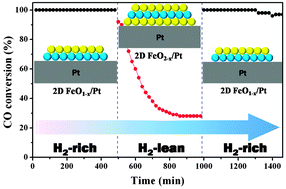Reversible structural transformation of FeOxnanostructures on Pt under cycling redox conditions and its effect on oxidation catalysis†
Abstract
Understanding dynamic changes of catalytically active

* Corresponding authors
a
State Key Laboratory of Catalysis, Dalian Institute of Chemical Physics, The Chinese Academy of Sciences, Dalian 116023, P.R. China
E-mail:
qfu@dicp.ac.cn, xhbao@dicp.ac.cn
b Shenyang National Laboratory of Materials Science, Institute of Metal Research, The Chinese Academy of Sciences, Shenyang 110016, P.R. China
c Advanced Light Source, Lawrence Berkeley National Laboratory, 1 Cyclotron Road, Berkeley, California 94720, USA
Understanding dynamic changes of catalytically active

 Please wait while we load your content...
Something went wrong. Try again?
Please wait while we load your content...
Something went wrong. Try again?
Q. Fu, Y. Yao, X. Guo, M. Wei, Y. Ning, H. Liu, F. Yang, Z. Liu and X. Bao, Phys. Chem. Chem. Phys., 2013, 15, 14708 DOI: 10.1039/C3CP52587B
To request permission to reproduce material from this article, please go to the Copyright Clearance Center request page.
If you are an author contributing to an RSC publication, you do not need to request permission provided correct acknowledgement is given.
If you are the author of this article, you do not need to request permission to reproduce figures and diagrams provided correct acknowledgement is given. If you want to reproduce the whole article in a third-party publication (excluding your thesis/dissertation for which permission is not required) please go to the Copyright Clearance Center request page.
Read more about how to correctly acknowledge RSC content.
 Fetching data from CrossRef.
Fetching data from CrossRef.
This may take some time to load.
Loading related content
